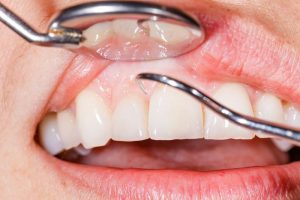
Periodontal Maintenance
Many patients are not aware that periodontal maintenance is the only sure way to keep gum disease from returning. Periodontal maintenance is regularly performed at certain intervals after procedures such as scaling and root planing. Periodontal maintenance includes the removal of plaque and tartar, scaling and tooth planing and polishing. Our dentist in Layton, UT will determine the frequency the periodontal maintenance is needed.
Biopsies
Throughout the medical field, a biopsy is simply the removal of a tissue sample to determine if it is diseases. In dentistry, teeth and gums are sent for biopsy. The role of a biopsy in the dental industry is to diagnose oral cancer. In these instances, a brush biopsy is used to identify oral lesions that warrant further attention.
If you have unexplained lesions in your mouth, they need to be examined by a dentist. They may or may not be cancerous, but they need medical attention nonetheless.
Osseous Surgery
Sometimes the effects of periodontal disease create permanent changes in the tooth and gum structure that will cause issues in the future. Enlarged gum pockets between the tooth and the gum line are common after having advanced gum disease. Sometimes these gaps are cosmetic in nature, and affect the appearance of the gums. More commonly, the gaps put the teeth at future risk for tooth and gum disease, as they are just one more place that plaque and bacteria can collect. Pocket reduction surgery is designed to thwart the after effects of periodontal disease and restore your mouth to a healthy state.
The goal of periodontal surgery to gain access to the tooth root and to clean the damaged areas. Once the dentist can visually see the damage, it can be removed completely. Removing the plaque and decayed gum tissue leaves a pocket between the gum and the tooth. Sometimes the gum returns to its original position, but still the pocket is present. The pocket requires more frequent cleanings as the patient is unable to get to the pockets with regular brushing and flossing. Once the swelling from the periodontal treatment has subsided, the dentist may need to suture the gum to where the bone has resorbed. The goal is to create a space large enough so it can be reached through daily oral hygiene, but small enough that it is not a breeding ground for plaque and bacteria.
Gum Disease Treatment
Periodontal (gum) disease is insidious. It is an infection of the gums that starts out as plaque, an opaque film on the teeth that hardens to form tartar. As tartar accumulates, it harbors bacteria that attack the soft tissue around the gums. This is the early stage of gum disease known as Gingivitis. Left untreated, Gingivitis becomes Periodontitis which ultimately destroys the tissue surrounding your teeth AND the bone that holds your teeth in place. Except for bad breath and gums that bleed, there are very few early warning signals. The disease advances silently, often without pain, and before you know it, you are losing your teeth and you don’t know why.
Tooth loss is only the most obvious indicator of gum disease. Scientific research has discovered linkage between gum disease and stroke, heart disease, diabetes – even an increased risk for pregnant women. When your gums become diseased, your entire immune system is weakened.
In the past, fear of painful dental surgery has kept people with gum disease from seeking the care they needed. Well, those days are gone forever.
Periodontal Splinting
Loose teeth are uncomfortable, especially when you try to eat food or chew gum. The feeling of the tooth pulling away from the gum is enough to send chills down your spine. It seems like an eternity, waiting for either the tooth to become loose enough to be extracted or strong enough to no longer be a problem.
Teeth become loose because of lost gum tissue, injury, orthodontic treatment, or pressure caused by tooth misalignment. A new technique called periodontal splinting attaches weak teeth together, turning them into a single unit that is stable and stronger than the single teeth by themselves. The procedure is most commonly performed on the front teeth. The procedure is as simple as using composite material to attach, or splint, the loose teeth to the adjoining stable teeth. Tooth splinting is a common procedure that has gained popularity in Layton, UT due to its effectiveness.
Scaling & Root Treatment Planning
Gingivitis is a generative disease that left untreated, will cause significant tooth and gum deterioration. Just the word gingivitis can strike panic in a patient’s mind. The reality is that the treatment is simple and performed right in our dentists office in Layton, UT.
Plaque and tarter that sits on the teeth provides an environment, which allows bacteria to thrive and multiply. The bacteria cause the gums to become inflamed and bleed. The condition becomes more noticeable when you brush your teeth or sometimes when you eat. These are signs of the early stage of gingivitis. Gingivitis is easily treated by having the hygienist scale and polish the teeth. If gingivitis is left untreated, the condition will progress and the roots will need a planing. The difference between scaling and root planing is simple. Scaling is the removal of the dental tartar from the tooth surface Root planing is the process of smoothening the root surfaces and removing the infected tooth structure.
As a non-surgical procedure, scaling and planing is performed without any anesthesia, in the dentist’s office. While the procedure is usually painless, advanced stages of gingivitis may make it necessary to numb the area for complete comfort. Deep scaling and root planing is usually broken down into one section of the mouth per appointment. This allows for adequate healing time, and reduces the time for each appointment.
If you have any questions about our services, please contact us today at (801) 775-8005.
